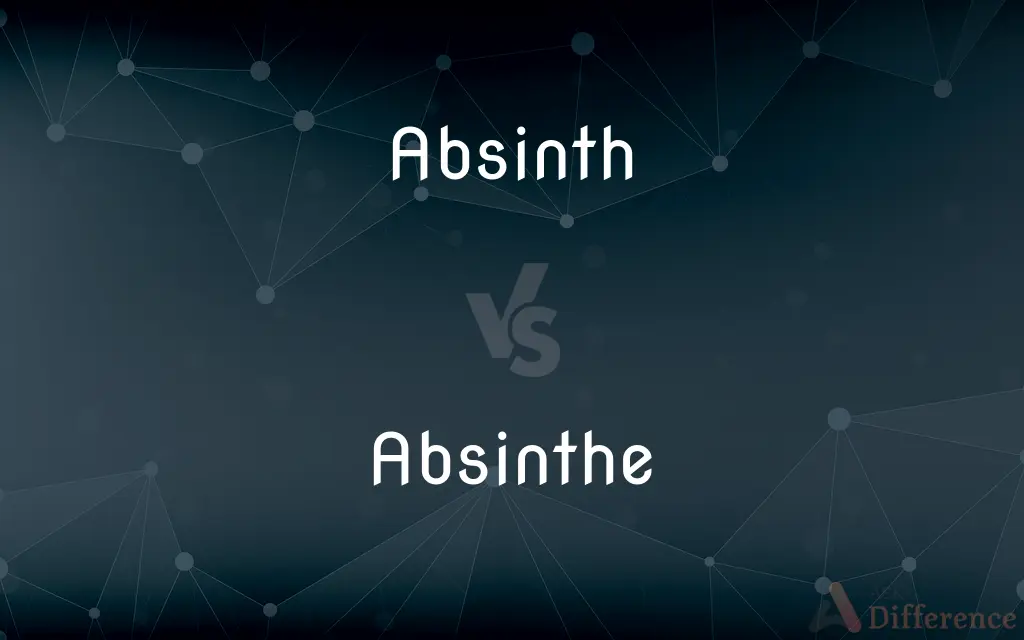Absinth vs. Absinthe — What's the Difference?
Edited by Tayyaba Rehman — By Maham Liaqat — Updated on April 1, 2024
Absinth refers to a less regulated version of the spirit, often lacking the traditional green color and anise flavor, while absinthe is a traditional, highly regulated herbal spirit known for its green color and complex flavor profile.

Difference Between Absinth and Absinthe
Table of Contents
ADVERTISEMENT
Key Differences
Absinth, often found in Eastern Europe, is a variant of absinthe that may not adhere to the strict definitions and quality standards of traditional absinthe. It sometimes lacks the characteristic green hue and can have a simpler flavor profile, focusing less on the herbal complexity that defines absinthe. On the other hand, absinthe is a traditional herbal spirit, originally from Switzerland and France, famous for its distinct green color, complex flavor, and high alcohol content. It is made with a variety of herbs, including wormwood (Artemisia absinthium), green anise, and fennel.
The production of absinthe follows a specific process that includes distillation and the infusion of herbs, which contributes to its unique taste and the louche effect when water is added. Absinth might be produced with a more flexible approach, possibly foregoing the distillation of certain herbs, leading to a variation in flavor and the absence of the louche effect.
Legal distinctions also play a role in these spirits' differences. Traditional absinthe has faced historical bans and strict regulations regarding its composition, particularly concerning thujone content (a compound found in wormwood). Absinth, especially versions produced in countries with less stringent regulations, may not meet these legal standards, allowing for a wider range of products under the name "absinth."
In terms of consumption, absinthe is traditionally served with water and a sugar cube, which is dissolved into the spirit through a special spoon and fountain apparatus to balance its bitterness. This ritual is less commonly associated with absinth, which might be consumed in a simpler manner due to its different flavor profile and the cultural practices of its primary consumers.
Both spirits have intrigued and inspired a cultural mystique, often associated with the bohemian lifestyle of late 19th and early 20th-century Europe. However, absinthe, with its rich history, complex preparation, and revival in the 21st century, remains the more celebrated of the two.
ADVERTISEMENT
Comparison Chart
Origin
Eastern Europe
Switzerland and France
Color
Often lacks traditional green color
Traditionally green
Flavor Profile
Simpler, may not include traditional herbal complexity
Complex, with a blend of herbs including wormwood
Production Process
May not follow traditional distillation and infusion
Involves distillation and herbal infusion
Legal Standards
Less regulated, varying thujone content
Highly regulated, especially regarding thujone content
Consumption Ritual
Less emphasis on traditional serving rituals
Traditionally served with water and a sugar cube
Historical Association
Less historically documented
Associated with bohemian lifestyle and art movements
Compare with Definitions
Absinth
A variant of absinthe often lacking traditional color and complexity.
The bar stocked a variety of Eastern European absinths.
Absinthe
A traditional herbal spirit known for its green color and complex flavor.
The artist sipped absinthe as he painted.
Absinth
Often consumed in a simpler manner.
They enjoyed absinth straight, without sugar or water.
Absinthe
Associated with a specific ritual involving water and sugar.
They prepared the absinthe with a special spoon and fountain.
Absinth
Sometimes produced with fewer regulations on herbal content.
He preferred the milder flavor of absinth to traditional absinthe.
Absinthe
Subject to strict regulations, including thujone content.
Modern absinthe adheres to regulations that limit its thujone content.
Absinth
May not produce the louche effect when water is added.
Unlike absinthe, the absinth remained clear when water was mixed in.
Absinthe
Symbolic of bohemian lifestyle and creativity.
Absinthe was a favorite among poets and artists in the late 19th century.
Absinth
Represents a broader category of wormwood-based spirits.
Absinth has become popular in countries with less strict regulations on spirit production.
Absinthe
Made with wormwood, green anise, and fennel.
The distinct flavor of absinthe comes from its unique blend of herbs.
Absinth
A perennial aromatic Eurasian herb (Artemisia absinthium) in the composite family, naturalized in North America and having pinnatifid, silvery, silky leaves and numerous nodding flower heads. Also called wormwood.
Absinthe
Absinthe (, French: [apsɛ̃t] (listen)) is historically described as a highly alcoholic spirit (45–74% ABV / 90–148 U.S. proof). It is an anise-flavoured spirit derived from plants, including the flowers and leaves of Artemisia absinthium ("grand wormwood"), together with green anise, sweet fennel, and other medicinal and culinary herbs.Absinthe traditionally has a natural green color but may also be colorless.
Absinth
A green liquor having a bitter anise or licorice flavor and a high alcohol content, prepared from absinthe and other herbs, prohibited in many countries when containing thujone because of its alleged toxicity.
Absinthe
A perennial aromatic Eurasian herb (Artemisia absinthium) in the composite family, naturalized in North America and having pinnatifid, silvery, silky leaves and numerous nodding flower heads. Also called wormwood.
Absinth
Alternative form of absinthe
Absinthe
A green liquor having a bitter anise or licorice flavor and a high alcohol content, prepared from absinthe and other herbs, prohibited in many countries when containing thujone because of its alleged toxicity.
Absinth
The plant absinthium or common wormwood.
Absinthe
The herb absinthium Artemisia absinthium (grande wormwood); essence of wormwood.
Absinth
A strong spirituous liqueur made from wormwood and brandy or alcohol.
Absinthe makes the tart grow fonder.
Absinthe
(figurative) Bitterness; sorrow.
Absinth
Strong green liqueur flavored with wormwood and anise
Absinthe
A distilled, highly alcoholic, anise-flavored liquor originally made from grande wormwood, anise, and other herbs.
Absinthe
(color) A moderate yellow green. 88c641
Absinthe
(US) Sagebrush.
Absinthe
Aromatic herb of temperate Eurasia and North Africa having a bitter taste used in making the liqueur absinthe
Absinthe
Strong green liqueur flavored with wormwood and anise
Common Curiosities
Is absinthe still banned in some countries?
Absinthe, as traditionally defined, is no longer banned in most countries, though it must meet specific regulations, especially concerning thujone content.
What is absinth?
Absinth is a variant of the herbal spirit absinthe, often found in Eastern Europe, with a simpler flavor profile and less strict production regulations.
Can absinth have the same effects as absinthe?
While both can have high alcohol content, the effects are primarily due to alcohol rather than thujone, the compound historically attributed to absinthe's psychoactive reputation.
Why is absinthe green?
Absinthe's green color comes from the chlorophyll of the herbs used in its production, particularly from the post-distillation infusion of herbs.
Are there different flavors of absinthe?
Yes, the flavor of absinthe can vary based on the blend of herbs used, with some recipes emphasizing different herbal notes, though wormwood, anise, and fennel are core ingredients.
How should absinthe be properly served?
Traditional absinthe service involves diluting the spirit with cold water poured over a sugar cube on a slotted spoon, balancing its herbal bitterness.
How does absinthe differ from absinth?
Absinthe is a traditional, highly regulated spirit known for its green color and complex herbal flavor, while absinth may lack these characteristics and adheres to less stringent production standards.
Has modern science debunked myths about absinthe?
Modern research has clarified that the psychoactive effects once attributed to absinthe are largely exaggerated, with its alcohol content being the primary cause of intoxication.
Why was absinthe associated with creativity and the arts?
Absinthe became a symbol of the bohemian lifestyle and creativity due to its popularity among artists and writers in the late 19th and early 20th centuries, who valued its flavor, ritual, and the social ambiance it fostered.
What is the louche effect?
The louche effect is the milky opalescence that occurs when water is added to absinthe, caused by the essential oils from the herbs being released into the water.
Share Your Discovery

Previous Comparison
Pungent vs. Spicy
Next Comparison
Socket vs. PlugAuthor Spotlight
Written by
Maham LiaqatEdited by
Tayyaba RehmanTayyaba Rehman is a distinguished writer, currently serving as a primary contributor to askdifference.com. As a researcher in semantics and etymology, Tayyaba's passion for the complexity of languages and their distinctions has found a perfect home on the platform. Tayyaba delves into the intricacies of language, distinguishing between commonly confused words and phrases, thereby providing clarity for readers worldwide.














































